
views
Learning Basic Music Theory
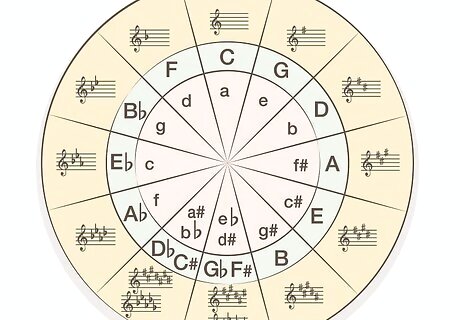
Familiarize yourself with common key signatures. Being familiar with the basic musical keys will give you a solid foundation for musical improvisation. Once you’re thoroughly familiar with a few key signatures, it will be easier for you to create melodies and harmonies that sound good. Start by learning the major diatonic key signatures and their relative minors. One good way to start is to memorize the “Circle of Fifths,” which shows all the major diatonic major keys and their related minor keys.Did you know? When you master a major diatonic key, you can easily play anything in the related minor, since they both have the same number of sharps or flats. C major and A minor are both easy keys to start with, since they contain no sharps or flats.
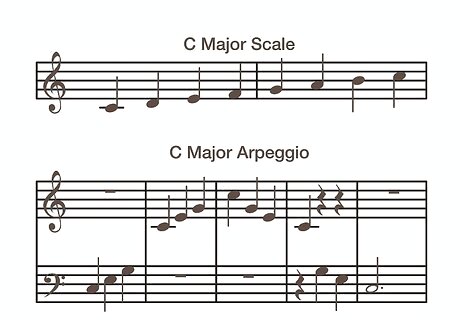
Practice scales and arpeggios. Scales and arpeggios are the basic building blocks from which melodies are built. Get thoroughly familiar with at least a few common diatonic scales and arpeggios so that you can start to develop an instinctive understanding of the different musical keys and their sounds. Start with a basic scale and arpeggio exercise book, such as Charles-Louis Hanon’s The Virtuoso Pianist. You can also find lots of scale and arpeggio exercises for free online.
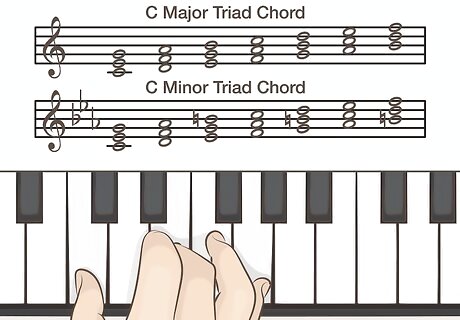
Learn the major and minor triad chords. Learning triad chords will give you a great starting point for creating harmonies when you’re improvising. Major triads are 3-note chords that consist of the root, third, and fifth notes of the scale. To create a minor triad, lower the third note by a half-step. Once you master the triads, you can experiment with building more complicated chords. For example, add the seventh note above the root chord to create a seventh chord. In the key of C, a basic seventh chord would consist of the notes C, E, G, and B. You can also create other interesting sounds by inverting the chords, or playing the notes of the chord in different orders. For instance, you can invert the A minor chord A-C-E by playing C-A-E instead.
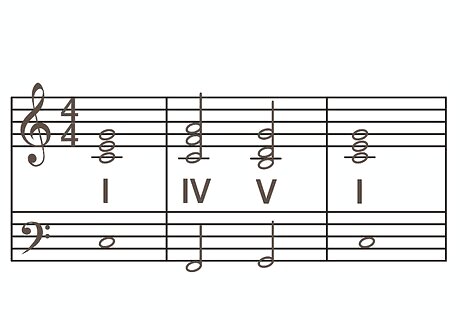
Get to know some basic chord progressions. Most songs in western music are built around a handful of common chord progressions. Spend some time getting familiar with some of the standard chord progressions in the genre you want to play. The chords in diatonic progressions are numbered using Roman numerals according to the position of each root note on the scale. For instance, if you’re playing in C major, the I chord is the C tonic triad (C-E-G). Minor chords are numbered with lower-case roman numerals (i, ii, iii, etc.). One common chord progression you might encounter is I-IV-V-I.
Working with a Known Melody
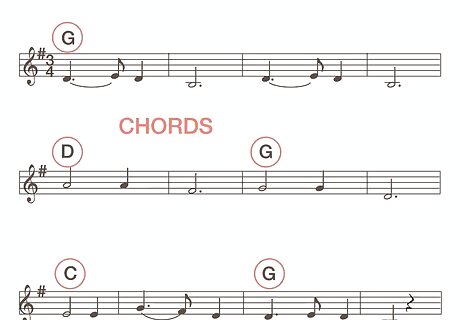
Choose a lead sheet if you need the melody written out. If you’re not familiar enough with the melody to play it by ear, start with a lead sheet (or fake sheet). A lead sheet consists of a simple melody with the accompanying chords written above the staff over the corresponding melodic notes.Tip: Look for lead sheets online, or buy a “fake book” with lead sheets for lots of standards in your favorite genre. For instance, you might see “C” or “D7” written over the melody line. The lead sheet shows you what basic chords to use and where the chord changes happen, but the notes of the chords aren’t written out for you. Experiment with playing different inversions, breaking up the chords into individual notes, or even changing the chords completely!
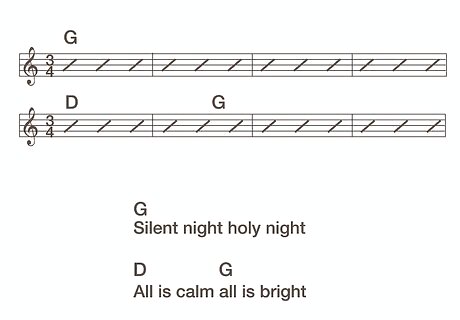
Work with a chord chart if you can play the melody by ear. If you’re already familiar with the melody, try a chord chart. Much like a lead sheet, a chord chart lists the basic chords that make up a song or musical piece. If you’re playing a song with lyrics, the chords may be written over the words to show where the chord changes happen. However, a chord chart doesn’t usually contain any musical notation. As you’re getting comfortable with the chord chart, try playing the chords along with the musical track or singing the lyrics while you play. This will help you figure out the feel of the piece and the best timing for the chord changes.

Try adding a walking bass using individual chord tones. You don’t have to stick to playing basic block chords in the bassline when you’re improvising. Try breaking the chords up into individual notes that “walk” up and down the keyboard along with the melody. For instance, if the first measure starts with a C chord, you could accompany the melodic notes in the right hand with a run of quarter notes in the left hand, such as C-E-G-C. Walking bass lines work especially well with jazz and blues melodies.
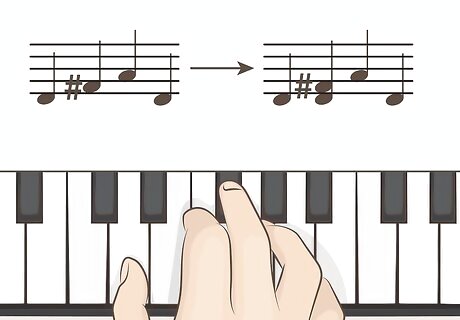
Add harmonies to the right hand once you’ve mastered the melody. Don’t feel restricted to playing chords and harmonies only with your left hand. Once you feel comfortable enough with the melody and the accompaniment, you can also start building chords into the right-hand part. For example, if there’s an F♯ in the melody and you’re in the key of D, you could add a D or A under the F♯ in the right-hand melody line.
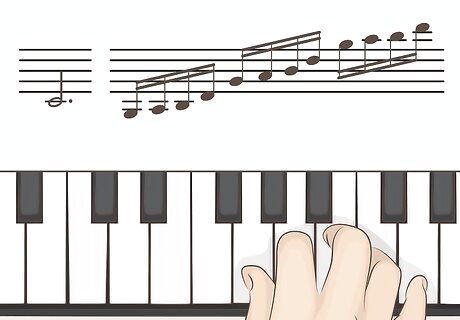
Create variations on the melody. Use your knowledge of scales, arpeggios, and chords to play with the melody even more. Experiment around to get a sense of what sounds or feels “right.” For example, you might try going up at the end of a measure where the melody originally dips down, or incorporating a run of notes from a scale.
Improvising from Scratch
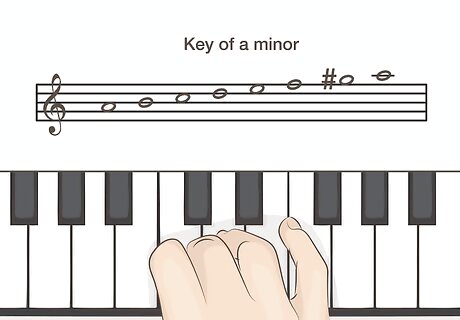
Choose a key for your improvised piece. If you know your key before you start playing, it will be much easier to create a foundation for your improv. Choose a key that you’re familiar with and that’s easy for you to play. For example, you might start with a key that has no or relatively few sharps or flats (black notes), such as C, A minor, G, or E minor.
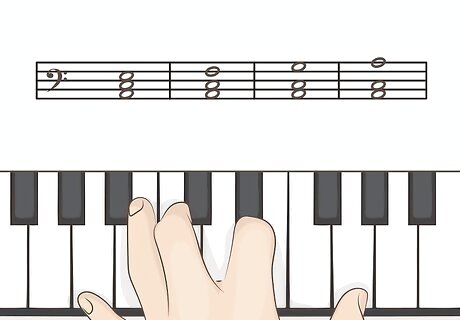
Establish a chord progression. Next, pick a simple series of 4 chords around which to build your improvised piece. The chord progression you pick will give the music a distinctive flavor (such as poppy or bluesy, upbeat or sad). You’ll play these chords with your left hand to accompany the improvised melody in the right hand. For instance, an I-V-vi-IV progression has an “optimistic” sound, while vi-IV-I-V sounds more somber or “pessimistic.” These are both variations on the same popular progression, but they have 2 distinct moods. Experiment with building on the basic chord progression you choose. For example, if you’re using vi-IV-I-V, you might go from vi to IV and back to vi again before moving on to I. You can also repeat a chord a few times before transitioning to the next one.Tip: Try breaking up the chords or inverting them to create different sounds or make your transitions smoother.
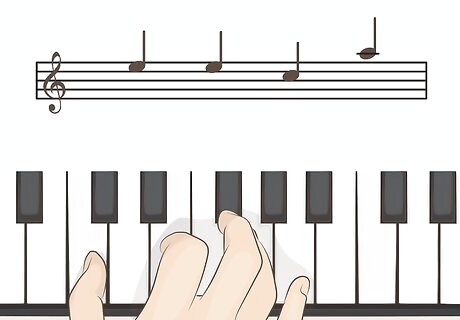
Pick a simple phrase as the foundation of your melody. Improvising a melody is easier if you use a basic phrase or “lick” as a building block. Choose a short, catchy snippet of melody the length of a single measure (e.g., 4 quarter notes). Try building the melody using notes from one of the chords in your progression. For example, if you’re playing in A minor, you might start with a simple lick that goes “E-E-C-A”.
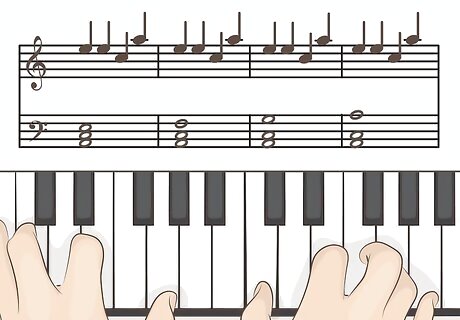
Play the phrase over each chord in your progression. Start by playing the same basic phrase over each chord. As you move through the progression, transpose the melody to the appropriate key for each chord. Analyze your phrase and examine the intervals between the notes and their relationships to the accompanying chord so that you can play it anywhere on the piano. For example, E-E-C-A consists of the fifth, third, and root notes of the A minor chord. To play this lick over the C chord, change it to G-G-E-C.
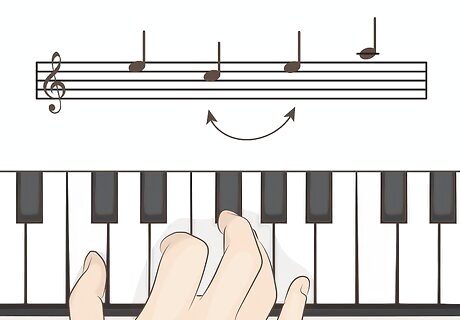
Experiment with variations on the main phrase. Once you’re comfortable playing your basic starting phrase along with each of the different chords in the progression, start getting creative! Using the same notes from your starting lick, experiment with playing them in different orders or with varying rhythms. You can also try adding new notes that are not part of the original lick. Try to repeat your main phrase occasionally to keep the melody cohesive. For example, you might repeat it at least once every time you do a chord change. EXPERT TIP Melissa McDermott Melissa McDermott Music Instructor Melissa McDermott is a Musician and accomplished Social Media Manager at coBranding Studio based in New York City. She has over seven years of experience teaching piano and music theory, she currently works as a Piano Instructor at O DiBella Music Inc. Additionally, she specializes in creating meaningful, informative, and quality social media content for health and wellness brands and musicians. Melissa received her B.A. in popular music studies from William Paterson University. Melissa McDermott Melissa McDermott Music Instructor Improvising on piano requires both knowing scales and trying new rhythms. Familiarity with musical scales, especially the minor blues, gives you the right notes to choose from. Once you've got the scales down, start playing with different rhythms and styles, translating the beats in your head onto the keys. Experimenting this way builds your improv skills.

Keep going even if you “mess up”. While your improv will sound best if you have a solid foundation of music theory to build on, remember that there are really no rules! Keep experimenting and being spontaneous, and try to go with the flow and move on even if you produce a sound you don’t like. As you keep practicing, you’ll eventually get a better idea of what works and what doesn’t.


















Comments
0 comment